Welcome to “Tips From Sticks-In-The-Mud Woodshop.” I am a hobbyist, not a professional, someone who loves woodworking, just like you do. I have found some better ways to accomplish tasks in the workshop and look forward to sharing those with you each month, as well as hearing your problem-solving ideas.
Building a small room (or even a compartment) for your dust-collection cyclone outside your shop provides several advantages.
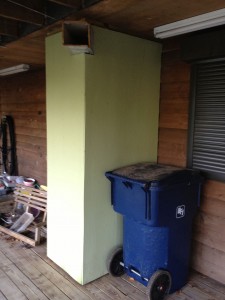
I built this little shack on the back of our house so the cyclone could be outdoors. Eventually I will side it with cedar, like the rest of the house, but with removable panels for cyclone maintenance. Meanwhile, it’s a big test panel for choosing the color of the house when it’s repainted.
First, all that noise is now outside instead of in your shop. And, that’s a big advantage, because even the quietest cyclone is pretty darn loud. I used my handy-dandy iPhone sound pressure level meter outside the closet, and it read 84 db. It can reasonably be assumed that it would have a similar noise output if inside the shop, except that if it were indoors it would probably not be enclosed and the sound would be even louder.
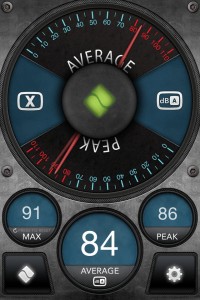
How much more pleasant would your shop be if the dust collector noise was gone, or at least reduced? 84 db is pretty loud.
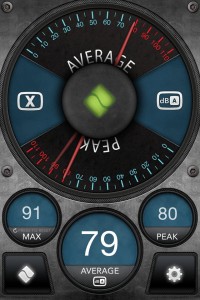
Just across the wall from the dust collector the reading was 79 db, roughly a 20% sound reduction compared to right next to the collector cabinet outdoors.
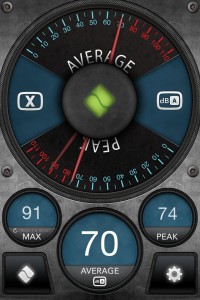
Meanwhile, stepping over about 12 feet to the table saw the reading was 70 db. We saved 9 dB of noise by just walking across the room!
Second, you’ve gained a little more room in your shop. Who can’t use more room? You may wish to size your new room to include your air compressor too, as Steven Johnson, the Down-To-Earth-Woodworker did.
Third, you may no longer need a filter on the air discharge, eliminating filter cleaning (one more unpleasant job). I just have to be careful that I don’t walk through that discharge area without a dust mask during and shortly after using the cyclone. For me it’s not a problem because it’s not an area I need to be in very often when I’m working. Whatever dust is in the discharge is the finest of the fine, because I never see anything in the air or even settling on that part of the deck. Of course, that really fine dust is also the most dangerous, the dust that can go deepest into your respiratory tree. One limiting factor is that you have to make a hole in the wall, and that hole has to line up perfectly so that your mounting bracket is in exactly the right place.

Not trusting myself in a challenge to match a hole to a mounting bracket, I mounted the cyclone first, then cut the hole!
You must provide “makeup air” to prevent pulling carbon monoxide and other products of combustion out of the flue and back into your shop.
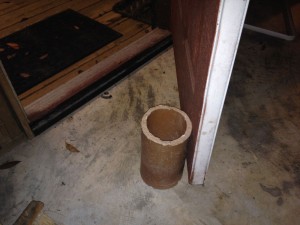
I use this old piece of orangeburg pipe to keep the back door cracked open for “makeup air” when running the cyclone.
Funny story: As it says in the footer, we live in the absolute boondocks. We have more wild animals in our back yard than a zoo. It’s nothing to see snakes on the deck, or even on the second floor. (I want to see one of them climbing the stairs one day.)
One night I had run the dust collector, finished and locked up for the night. The next morning I went down the stairs to leave for work and there was a big pile of smelly poop on a rug. Clearly it wasn’t dog or cat poop because it was full of persimmon seeds. I hurriedly cleaned it up and didn’t give it much more thought, despite the fact that the entire garage was locked up tight. Several days later, on the weekend, I was going around the north wall opening blinds, shutters and windows, when I found even more seed-filled poop. Then more. I decided I needed to look for a source. Now, it’s important to know something about me: I get spooked pretty easily. And, when I get startled, I can scream just like a girl. I armed myself with an old broom handle and began my search. Under the cars, under the boat, under the workbench where my infrequently-used jigs are stored. Nothing. “OK, then,” I thought, “let’s go to the real hiding places, my wife’s clay and pottery-working area.” Still nothing. Talking to myself again, “Maybe a coon got in and got out and just left me some ‘prizes’ while he was here.” I resigned myself to never solving the mystery and went back to work. Cutting a heavy piece of metal with a saber saw, I had Bose noise-canceling headphones on and was playing music pretty loud, when I felt something against my foot. Not thinking of my intruder, I wiggled my foot and continued cutting. I felt something hit my boot again and looked down.
:Insert girl-scream here:
It’s a good thing my wife wasn’t home or she would have thought I’d run the radial arm saw over my wrist. I looked down to see the cutest little baby possum you ever saw! Sure, I didn’t think he was so cute at first, but when my heart rate dropped back below 200 I was able to admire him objectively, I decided he was adorable. Still, he’d be even more adorable if he was back in the swamp where he belonged. Grabbing an empty 5-gallon bucket I scooped him up (did I mention the poop piles really stank?), carried him well away from the house and let him re-join nature. I don’t believe he wants to face the six-foot-tall screaming “monster” again.
Jim Randolph is a veterinarian in Long Beach, Mississippi. His earlier careers as lawn mower, dairy farmer, automobile mechanic, microwave communications electronics instructor and journeyman carpenter all influence his approach to woodworking. His favorite projects are furniture built for his wife, Brenda, and for their children and grandchildren. His and Brenda’s home, nicknamed Sticks-In-The-Mud, is built on pilings (sticks) near the wetlands (mud) on a bayou off Jourdan River. His shop is in the lower level of their home. Questions and comments on woodworking may be written below in the comments section. Questions about pet care should be directed to his blog on pet care, www.MyPetsDoctor.com. We regret that, because of high volume, not all inquiries can be answered personally.


i just discovered your column just down to earth southern smarts thanks for the ideas